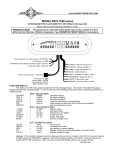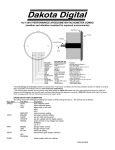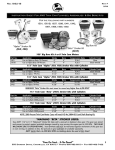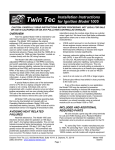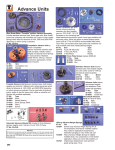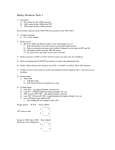Download Dakota Digital 5000 Series Service manual
Transcript
MCL-5100, 5200, & 5400 Bar mount digital speedometer with indicators. *To avoid damage to motorcycle, please see Speedometer and Indicators sections for details on locating VSS and indicator wires for most motorcycle applications **The Check Engine indicator will not function using this gauge on 2004+ HD models due to the signal being fed through the ‘data bus’, however the HD diagnostic tool can still check and clear codes through the diagnostic connector. SPEEDOMETER Failure to calibrate the speedometer may cause your odometer mileage to increase very rapidly. The speed input connector plugs into the speed sensor to tell how fast you are traveling. On cable driven applications, the SEN-6011 (sold separately) connects to the speedometer cable and provides the electric signal. This sensor has a 5/8” coarse thread fitting that accepts mid-80’s and earlier cables directly. For 16mm cables, the nut on the end of the cable can be changed. For cycles with smaller metric ends, the speedometer cable will need to be replaced with a cable having the correct fitting. Custom cables can be made, or stock cables can be modified for many of the Metric applications. With transmissions having the built-in electric sensor, the supplied three-wire harness adapter connects the transmission speed sensor to the speedometer. This system will also accept most after-market inductive, Hall-effect, or ground switch sensors. For 3-wire Hall-effect sensors, refer to the installation instructions for the sensor to determine wire color code. Most 3-wire sensors use the following color code: RED – power, BLACK – ground, WHITE – speed signal. Connect the sensor signal wire to the GREEN wire from the 3-wire harness, connect the sensor power wire to the red wire from the 3wire harness, and connect the sensor ground wire to the black wire from the 3-wire harness. For speed sensor integrated into a vehicle wiring harness(most Metric Cruisers w/factory VSS utilize a 3-wire Hall-effect sensor), consult a service manual to determine the color code and location of the speedometer signal. If the factory harness supplies +5V to the sensor, utilize the factory connection in place of the red power wire. For 2004+ Harley and 2003+ V-Rod applications, make sure to simply “Tee” into the white (or white/green) wire on the speed sensor to make certain the ECM will still receive its proper VSS signal from the sensor. Disconnecting the speed signal from the ECM may cause the bike to run poorly. 2006+ Sportsters utilize a black/blue wire for the VSS signal in place of the white wire on most big-twin models. The speedometer is fully adjustable and calibration is described in the following pages. VSS wires should be isolated from the ignition system. Coils, plug wires, or tachometer signal wires routed near or with the VSS wire can cause: erratic speedometer operation, speed reading at a standstill, incorrect or difficult calibration. MAN# 650224 A POWER Connect the red wire from the main harness to accessory power from the ignition switch. Never connect this to a battery charger alone. It needs to have a 12 volt battery connected to it. Battery chargers have an unregulated voltage output that will cause the system to not operate properly. GROUND The black wire is the main ground for the gauge. A poor ground connection can cause improper or erratic operation. STATUS AND WARNING INDICATORS The right turn, left turn, and high beam indicators are activated by a 12 volt input signal. The right turn signal wire is GREEN, the left turn signal wire is ORANGE, and the high beam wire is PURPLE. The indicator harness can be connected to the same wires that the stock indicator lights would be connected to. The MCL-5000 wire colors may not match the wire colors in your electrical wire harness. The neutral, low oil, and check engine indicators are activated by a ground signal. The low oil wire is BROWN, and the neutral wire is WHITE/GREEN. The check engine wire is PINK, but will not function on 2004+ HD models due the signal being controlled via the data bus. MOUNTING: A mounting bracket must be purchased for your application. Any BKT-50xx series bracket may be used. The bar mount brackets can be used for above-the-bar mounting or below-the-bar mounting. The 35° triple-tree mounts are only available for above-the-bar mounting. The triple-tree mounting bracket replaces the original handle bar top clamp. The gauge attaches to the back side of the bracket with the supplied screws. The bar mount brackets have a curved front bracket and two rear brackets. The longer screws attach the gauge to the back side of the bracket and the shorter screws go into the recessed openings on the rear brackets. The mount fits tight and will need to be pulled together by the screws. To mount the gauge under the bar: 1. Remove the rear plate by unscrewing the four screws. 2. Rotate the rear plate so the mounting tab is on the top. 3. Reattach the rear plate using the four screws. 4. Place bar mount bracket on the handle bars so that the recessed screw holes are on the top. 5. Using the long screws, secure the gauge to the bottom side of the bar mount bracket. Drawings for using bar mount brackets above the bar and below the bar. MAN# 650224 A SPEEDOMETER CALIBRATION Failure to calibrate the speedometer may cause your odometer mileage to increase very rapidly. The speedometer calibration is done using the function switch. The speedometer can be calibrated two different ways. The first method is to place the unit in auto-cal mode and drive exactly one mile (one km for metric). The second method is to place the unit in adjust mode and the speed reading can be moved up or down while driving. The function switch is on the right side of the front gauge face. The displayed unit can be either MPH or km/h. This is selected in the “LAb” menu and does not affect the calibration. METHOD 1, AUTOCAL 1. Make sure the key is off so the gauge is not powered. 2. Press and hold the function switch. 3. Turn the key on. With the switch still held, start the engine. The display will show “5xx”, where “xx” is the current software code. 4. Release the function switch. The display will switch between “CAL” (auto cal), “AdJ” (adjust), “LAb” (label), and ngt (night dim). 5. When “CAL” is displayed press the function switch. This will place the unit in auto calibration mode. 6. Release the function switch. The display will show -0.0. 7. Drive exactly one mile (or 1km). The number will increase as it counts up the pulses received from the speed sensor. 8. Press and release the function switch. The calibration value will be calculated and stored. The gauge will now restart in normal mode with the new speed calibration. METHOD 2, ADJUST SPEED 1. Make sure the key is off so the gauge is not powered. 2. Press and hold the function switch. 3. Turn the key on. With the switch still held, start the engine. The display will show “501 “. 4. Release the function switch. The display will switch between “CAL” (auto cal), “AdJ” (adjust), “LAb” (label), and ngt (night dim). 5. When “AdJ” is displayed press the function switch. This will place the unit in calibration adjustment mode. 6. Release the function switch. The display shows the speed and flashes continuously. 7. Drive at a known speed. Following another vehicle that is driving at a constant, known speed is one way to do this. 8. Press the function switch. The speed reading will begin increasing until the function switch is released. The next time the function switch is pressed, the speed reading will begin decreasing until it is released. 9. Once the speedometer is reading correct release the function switch. The new calibration will be saved if no adjustments are made for 7-10 seconds. SPEEDOMETER UNIT SELECTION The displayed unit can be either MPH or km/h. This is selected in the “LAb” menu and does not affect the calibration or speedometer readings. Correcting or changing the speedometer reading is done with the calibration steps discussed above. To change the display label follow the steps above and press the function switch when “LAb” is shown. The current label will be displayed. Pressing and releasing the switch will change the label. Pressing and holding the label will save the new setting. FUNCTION SWITCH/READING MILEAGE The function switch is located on the right side of the gauge face. The function switch is used for calibration and to read out the odometer mileage. Pressing and holding the function switch while the gauge is running will display the odometer mileage as follows: “odo” > thousands > hundreds > tenths 65,432.1 would be displayed as follows: “odo” > “ 65” > “432” > “ .1” Pressing and releasing the function switch while the gauge is running will display the trip mileage as follows: “trP” > hundreds > tenths 123.4 would be displayed as follows: “trP” > “123” > “ .4” The trip mileage will continue to be displayed until the function switch is momentarily pressed again. Pressing and holding the function switch while the trip mileage is being displayed will reset it to zero. NIGHT DIMMING Your display system has a dimming feature that dims the display intensity automatically at night. Normally the system is at full brightness for daytime viewing. To have the system at full brightness all of the time, go into the setup menu as described above and select “ngt” (night). Press and release the function switch to select “OFF” instead of “on”. Press and hold the function switch to save the new setting. MAN# 650224 A Please consult service manual for correct wire colors. 1996-2003 Harley Davidson wiring All signal wires should be found behind the speedometer along with power and ground. Indicators should be at the indicator panel. Signal Power Ground Right Turn Neutral Oil Engine Left Turn High Beam VSS Power Ground Signal Bike Orange Black Green Tan Green/Yellow Black/Yellow Violet White Harness Red Black Green White/Green Brown Pink Orange Purple Red Black White Red Black Green 2004-2007 Harley Davidson wiring The power and ground can be found behind the speedometer. Speed signal will need to be run to the ECU or cruise control module where you should find the wire colors listed here. This is due to the data bus configuration. Indicators should be at the indicator panel. Signal Bike Harness Power Orange Red Ground Black Black Right Turn Brown Green Neutral Tan White/Green Oil Green/Yellow Brown Engine N/A Pink (not used) Left Turn Violet Orange High Beam White Purple VSS Power N/A Red (not used) Ground N/A Black (not used) White/Green Signal (Pin 33 @ ECU) Green 2008 Harley Davidson wiring The power and ground can be found behind the speedometer. Speed signal will need to be run to the ECU where you should find the wire colors listed here. This is due to the data bus configuration. Indicators should be at the indicator panel. Signal Bike Harness Power Orange Red Ground Black Black Right Turn Brown Green Neutral Tan White/Green Oil Green/Yellow Brown Engine N/A Pink (not used) Left Turn Violet Orange High Beam White Purple VSS Power N/A Red (not used) Ground N/A Black (not used) White/Green Signal (Pin 40 @ ECU) Green NOTE: The installer must consult the service manual, verify wire locations, and check voltages prior to making any connections. Dakota Digital makes no representation or warranty with respect to the above information including its accuracy, completeness, or its freedom from third parties proprietary rights. Dakota Digital disclaims all liability or responsibility for errors or omissions therein or any decision made by the recipient in reliance theron. MAN# 650224 A Troubleshooting guide. Problem Gauge will not light up Gauge lights up, but displays “Er1” Gauge lights up, but displays “Er3” Gauge lights up, but displays “Er6” Gauge lights up, but speed will only show zero. Speed reading is erratic or jumps around. Possible cause Red wire does not have power. Black wire is not getting a good ground. Gauge is damaged. Speed power out wire is shorted to ground. Speed calibration is invalid Solution Connect to a location that has power. Internal malfunction, speed accuracy may be reduced. Harness is not connected properly. Speed sensor not grounded properly. Speed sensor is not being turned by the cable. Press switch to clear error, if error continues then gauge must be returned for repair Check connection from speed harness to speed sensor and gauge. Move ground to different location, preferably close to the speedometer ground. Check cable connection between sensor and cable drive. The sensor can be tested by spinning the cable with a drill. See speed sensor voltage checks listed below. Sensor is not sending a speed signal. Gauge is not calibrated Speed sensor wire is loose or broken. Cable is loose or broken. Poor ground connection. Poor power connection. Speed reading is incorrect. High beam, Left turn, or Right turn indicator does not work. Gauge is not calibrated correctly. Loose or incorrect connection to indicator wire. Neutral, low oil, or engine indicator does not work. Loose or incorrect connection to indicator wire. Connect ground to a different location. Return gauge for repair. Check wire connections from red wire to speed sensor. Gauge must be recalibrated. Gauge must be calibrated, see instructions on page 2. Check all wire connections and cables for breaks. Check cable between sensor and transmission or front wheel. Check ground on speedometer and sensor. Check that power is not connected to a noisy source such as ignition coil power. Gauge must be calibrated. Check that the appropriate indicator wire has about 0 volts when the indicator should be off and about 12 volts when the indicator should be on. Check that the appropriate indicator wire has about 12 volts when the indicator should be off and about 0 volts when the indicator should be on. Speed sensor voltage checks. All checks should be made with the sensor connected to the gauge and the key on. Checks should be done with a volt meter and not a test light. 3-wire sensor: Red wire should have 9-11 volts dc, slightly less than battery voltage. Black wire should show ground, 0 volts dc at all times. White wire should vary between 0 and 5 volts dc as the gear teeth pass by the sensor. 2-wire sensor: Measure the voltage between the two sensor wires. With the wheel spinning the voltage should be about 1-10 volts ac (make sure the meter is set to AC volts and not DC volts for this check). MAN# 650224 A SERVICE AND REPAIR DAKOTA DIGITAL offers complete service and repair of its product line. In addition, technical consultation is available to help you work through any questions or problems you may be having installing one of our products. Please read through the Troubleshooting Guide. There, you will find the solution to most problems. Should you ever need to send the unit back for repairs, please call our technical support line, (605) 332-6513, to request a Return Merchandise Authorization number. Package the product in a good quality box along with plenty of packing material. Ship the product by UPS or insured Parcel Post. Be sure to include the RMA number on the package, and include a complete description of the problem with RMA number, your full name and address (street address preferred), and a telephone number where you can be reached during the day. Any returns for warranty work must include a copy of the dated sales receipt from your place of purchase. Send no money. We will bill you after repair. Dakota Digital 24 Month Warranty DAKOTA DIGITAL warrants to the ORIGINAL PURCHASER of this product that should it, under normal use and condition, be proven defective in material or workmanship within 24 MONTHS FROM THE DATE OF PURCHASE, such defect(s) will be repaired or replaced at Dakota Digital’s option. This warranty does not cover nor extend to damage to the vehicle’s systems, and does not cover removal or reinstallation of the product. This Warranty does not apply to any product or part thereof which in the opinion of the Company has been damaged through alteration, improper installation, mishandling, misuse, neglect, or accident. This Warranty is in lieu of all other expressed warranties or liabilities. Any implied warranties, including any implied warranty of merchantability, shall be limited to the duration of this written warranty. Any action for breach of any warranty hereunder, including any implied warranty of merchantability, must be brought within a period of 24 months from date of original purchase. No person or representative is authorized to assume, for Dakota Digital, any liability other than expressed herein in connection with the sale of this product. MAN# 650224 A






